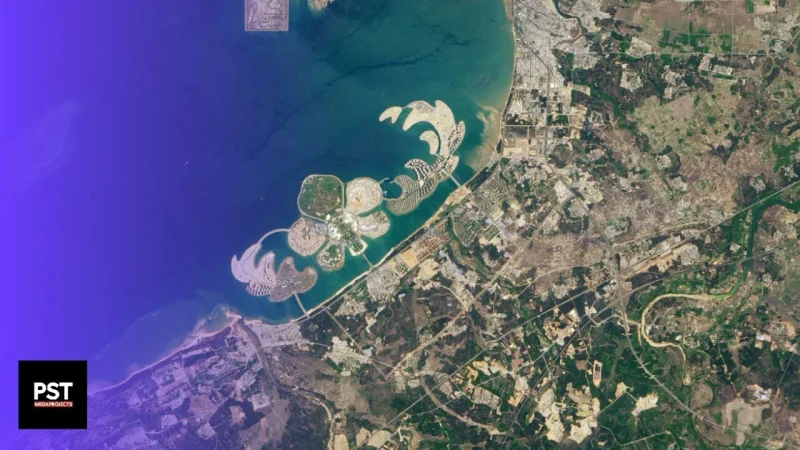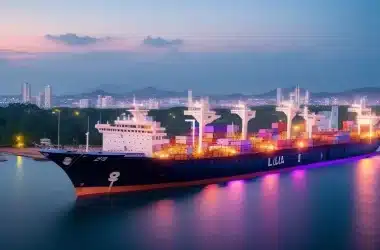China’s captivating Ocean Flower Island in the province of Hainan is the largest artificial island in the world. It’s a massive $25 billion megaproject intended to become a dazzling tourist haven, but three years after it was supposed to be completed, parts of it sit completely abandoned, and clouds of uncertainty started surrounding its future.
This is because the developer behind the project, the Evergrande Group, is entangled in a web of constraints with a staggering $300 billion in debt, raising the question: will the world’s largest artificial island ever be fully completed?
Hainan Province
Hainan, a province off the coast of Mainland China, is home to over nine million residents. It’s known for its tropical climate, beach resorts and forested, mountainous interior, making it one of China’s most important tourism hubs.
In fact, Hainan welcomed 26 million tourists in the first quarter of 2023, generating a revenue of more than $7.35 billion. The province’s strong tourism potential is what led China to start developing Ocean Flower Island, or Haihua in Chinese. Project planners had envisioned that the island would attract millions of tourists every year and boost the province’s economy, similar to how other artificial island projects around the world helped their countries.
The plans for the Ocean Flower Island were announced way back in 2010, and satellite imagery captured the first leaves of the flower appearing on top of the ocean in 2012, which was the earliest sign of the island. Two years later in 2014, the main flower-shaped island began to take shape, and in 2020, all the land reclamation work was completed.
Ocean Flower Island
This massive project is basically three separate islands linked together by a causeway, forming the shape of a peony flower. They span across 1,980 acres, which makes it 1.5 times bigger than Dubai’s famed Palm Islands. Notably, one of the three islands is directly connected to Hainan province.
These three different islands were all created for different uses. For example, the project’s central area, known as Ocean Flower Island No.1, is designed to be a self-contained holiday destination, with various different attractions like Fairy Land, a fantasy-themed amusement park, and Snow Mountain, a grand waterpark. Additionally, it includes futuristic-looking skyscrapers next to recreations of historic city scapes, and an opera house as well as multiple hot springs.
It also has impressive botanical gardens, and a large marine aquarium. Of course, to accommodate tourists, Haihua is home to duty-free shopping malls and a dozen Michielin-starred restaurants, as well as a number of luxurious hotels.
As for the project’s No.2 and No.3 areas, they are for residential units, and are meant to house around 115,800 people. However, if you take a look at the island’s satellite images, you’d see that these residential areas aren’t completely finished. In fact, only 50% of the island’s land mass is fully developed by one of China’s leading real estate developers, Evergrande Group, for the cost of $25 billion, even though the island was scheduled for completion in 2020 after 12 years of construction.
According to the promotional materials, Evergrande compared this project to Dubai’s Palm Islands, as it’s also split between an area meant to attract tourists and residential areas for citizens to live in. It’s no surprise that China would want its own Palm Islands, since they were built to triple the number of tourists that visit Dubai annually, from 5 million to 15 million.
Why is it a Failure?
Despite the fact that this is a really good project with brilliant engineering behind it, it’s still considered a failure.
There are multiple reasons why Ocean Flower Island wasn’t a success. For starters, the megaproject was pushed forward by Zhang Qi, a local politician who was later convicted of corruption and accused of overruling environmental protection laws to allow the construction of the island.
Zhang Qi’s arrest tainted the image of the project, and the construction resulted in so much damage to coral reefs and oyster populations in the area that Evergrande had to pause construction in 2018.
Demolition
There’s also the fact that the Evergrande Group was ordered to demolish 39 buildings in the residential areas of the Ocean Flower Island, as it was said that the buildings were only given the green light after permits for their construction were obtained illegally.
What made this even worse is that those buildings weren’t incomplete developments, but apartment complexes that were already sold. This caused outrage between Chinese citizens, who thought the government should’ve taken the buildings from Evergrande and used them for something else, instead of asking Evergrande to demolish them.
Evergrande didn’t specify when exactly the buildings will be demolished, and the latest reports regarding the issue said that the real estate developer was actually negotiating with the local government to find an alternative solution and not demolish the buildings.
This isn’t the first time Ocean Flower Island was ordered to demolish buildings. In fact, it was also ordered to take down four culvert bridges that were built illegally in 2019, and formed an illegal sea enclosure of about 912 acres.
And this isn’t all, in fact, it might surprise you to know that the construction of this megaproject was illegal from the very beginning.
Illegal Megaproject
According to a Chinese law, the sea area of local projects shouldn’t exceed 67 acres, and if the size of the project exceeds that, it needs to be reported to the provincial government in the state council for approval. Evergrande’s land reclamation, on the other hand, spanned 1,930 acres. By now, you must be wondering, how on earth did it manage to do that?
Local officials in Hainan played a part in that. They applied a special method to approve the project. They split the reclamation project into 36 sub-projects of less than 67 acres, approving 18 of them in January of 2013, and the other 18 were approved in July of the same year.
Evergrande’s Debt Crisis
Demolishing buildings aside, Evergrande’s real troubles began when the Chinese government imposed the Three Red Lines policy to tighten regulations on how real estate companies got financing for their projects, and that sent the company into a massive debt crisis.
In 2021, the company quickly became the face of China’s real estate crisis when it defaulted on its $300 billion debt. The company has attempted to restructure its debt ever since, and even filed for bankruptcy in the United States.
The Chinese government attempted to help the struggling real estate sector by giving property developers billions of dollars to finish and deliver uncompleted apartments, but everything changed when Evergrande was ordered by a Hong Kong court to liquidate all of its assets in 2024.
There’s still little clarity over how the liquidation of Evergrande will unfold, because the legal systems of Hong Kong and mainland China are distinct, meaning that courts in China could just ignore that liquidation order.
But, even if that happens, Hong Kong will have the power to seize Evergrande’s assets in Hong Kong, and sell them to raise funds to repay international creditors.
What’s Next for Ocean Flower Island?
The fact that Evergrande is in serious trouble means that Ocean Flower Island’s fate is now unpredictable. For one, half of it is still unfinished, and it definitely won’t be developed if Evergrande ceases to exist. On the other hand, the island could become a target of Evergande’s international creditors, who will want to claim it or parts of it to recover some of their losses.
But, the likelihood of this happening is unclear, since international creditors might not be able to do that if courts on Mainland China don’t recognize the Hong Kong court’s ruling. Notably, Evergrande is still building and selling apartments in mainland China, even though it has been unable to repay its debts.
In early 2023, the company had completed and delivered a total of 421,000 homes across the country over a 14-month period, and months later, it released its interim report for 2023, which showed that it sold $4.7 billion worth of apartments in the first half of last year.
This could mean that hope for Ocean Flower Island isn’t completely lost, and even if Evergrande ends up losing it, another developer could pick the project up and put it back on track Today, Ocean Flower Island is open to the public in Hainan, with a large number of its attractions already in operation, and while its future is now uncertain, it’s still an incredibly beautiful project that showcases engineering genius.
Disclaimer
Please visit and read our disclaimer here.









